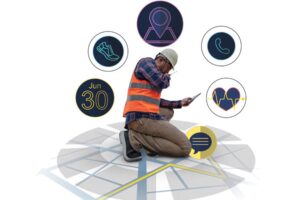
The role of smart sensor protect workers in security
Smart sensors can play an important role in protecting workers in security-related jobs by providing real-time data on potential hazards and alerting workers to potential dangers. These sensors can be used in a variety of settings, including factories, construction sites, and other high-risk environments. One example of a smart sensor protect workers is a gas detector.
Gas detectors can detect potentially hazardous gases such as carbon monoxide, methane, and hydrogen sulfide. If the sensor detects the presence of these gases, it can alert workers and supervisors to take appropriate action, such as evacuating the area or shutting down equipment.
Another example of a smart sensor protect workers is a motion detector. Motion detectors can be used to monitor areas where workers are operating and can alert workers and supervisors if someone enters the area without authorization or if there is unusual activity.
Smart sensors can also be used to monitor the health and safety of workers in real-time. For example, sensors can be used to track the body temperature of workers to ensure they are not overheating or at risk of heat exhaustion. Similarly, sensors can be used to track the heart rate and other vital signs of workers to ensure they are not overexerting themselves or experiencing other health problems.
Overall, smart sensors can provide workers and their supervisors with valuable information and real-time alerts to help protect them from potential hazards and improve safety in high-risk environments.
how smart sensor protect workers in Different work
Smart sensors can protect workers in different types of work by monitoring various environmental factors and providing real-time data to identify potential hazards. Here are a few examples of how smart sensors can protect workers in different work settings:
Manufacturing: In a manufacturing plant, smart sensors can detect dangerous gases, such as carbon monoxide and methane, and alert workers to potential hazards. They can also monitor the temperature and humidity levels to prevent heat-related illnesses and ensure a safe working environment.
Construction: Smart sensors can monitor the noise levels and detect potentially hazardous materials like asbestos or lead in construction sites. They can also track the location of workers to ensure they do not enter restricted areas, and alert them to potential dangers like falling objects or moving machinery.
Smart sensor protect workers in Mining: In mining operations, smart sensors can detect harmful gases, like sulfur dioxide and methane, and alert workers to evacuate if necessary. They can also monitor the levels of dust in the air to prevent respiratory problems.Healthcare: Smart sensors can monitor the health of healthcare workers, including their heart rate and body temperature, to ensure they do not overexert themselves or become overheated while wearing protective equipment. They can also detect the presence of infectious diseases and alert workers to take appropriate precautions.
Office: Smart sensors can monitor the air quality in an office environment, detecting high levels of carbon dioxide or volatile organic compounds (VOCs) that can cause headaches, dizziness, and other health problems. They can also monitor the temperature and humidity levels to ensure a comfortable and safe working environment.
In each of these work settings, smart sensors can provide workers and their employers with valuable data to help identify potential hazards and prevent accidents and injuries.
The role of smart sensor protect workers
Smart sensors can play an important role in protecting people, property, and the environment in a variety of ways. Here are some of the ways that smart sensors can protect:
Early Detection of Hazards: Smart sensors can detect potential hazards like gas leaks, fires, and floods early on, allowing for a timely response and minimizing damage to property and the environment. For example, a smart smoke detector can detect the early signs of a fire and alert the occupants, giving them time to evacuate and minimizing property damage.
Improving Safety in High-Risk Environments: Smart sensors can monitor environmental factors like temperature, humidity, and air quality, and detect potentially hazardous materials or gases. They can alert workers or occupants in high-risk environments to potential dangers and help prevent accidents and injuries.
Preventing Equipment Failure: Smart sensors can monitor the performance of equipment and detect signs of wear and tear, allowing for timely maintenance and preventing equipment failure. For example, a smart sensor can detect a drop in oil pressure in a car engine and alert the driver to take action before the engine fails.
Enhancing Security: Smart sensors can be used to detect unauthorized access to buildings, vehicles, or other secure areas, helping prevent theft and vandalism. They can also detect the presence of intruders and alert authorities or occupants, helping to prevent crimes like burglary and trespassing.
Environmental Monitoring: Smart sensors can be used to monitor environmental factors like air quality, water quality, and weather conditions, helping to protect the environment and ensure public health and safety.
Overall, smart sensors can provide valuable real-time data and alerts that can help prevent accidents, protect property and the environment, and improve safety and security in a variety of settings.
what smart sensor protect?
Smart sensors can protect workers, people, property, and the environment in a variety of ways. Here are some examples of what smart sensors can protect:
Personal Safety: Smart sensors can protect individuals by monitoring their health and safety in real-time. For example, wearable sensors can track vital signs like heart rate and blood pressure and alert medical professionals in case of an emergency.
Property Protection: Smart sensors can protect property by detecting potential hazards like fires, gas leaks, and floods. For example, a smart smoke detector can detect the early signs of a fire and alert the occupants, helping to minimize property damage.
Environmental Protection: Smart sensors can protect the environment by monitoring air quality, water quality, and weather conditions. For example, sensors can detect harmful pollutants in the air or water and alert authorities, helping to prevent environmental damage and public health hazards.
Equipment Protection: Smart sensors can protect equipment by monitoring performance and detecting signs of wear and tear. For example, sensors can detect changes in oil pressure in a car engine and alert the driver to take action before a breakdown occurs.
Security: Smart sensors can protect against security threats by detecting unauthorized access to buildings, vehicles, or other secure areas. For example, sensors can detect the presence of intruders and alert authorities, helping to prevent crimes like burglary and trespassing.
Overall, smart sensors can protect people, property, and the environment from a variety of potential hazards and threats by providing real-time data and alerts.
